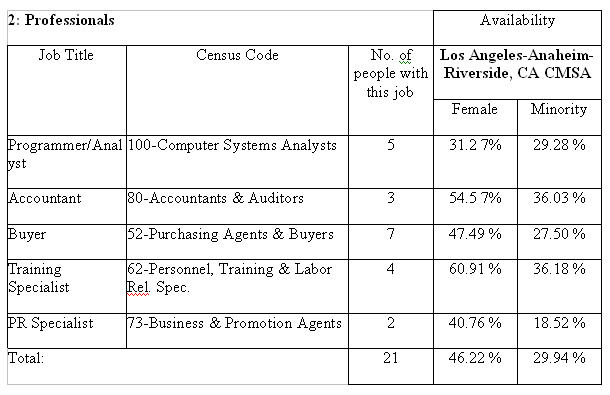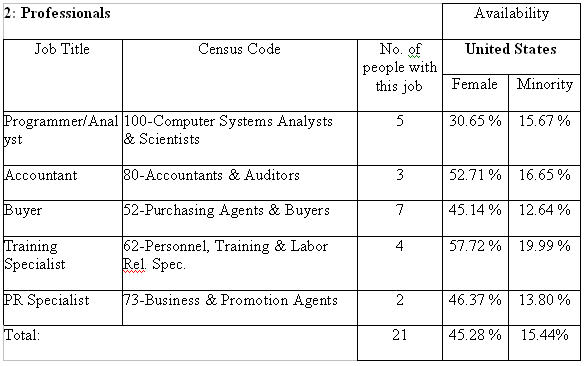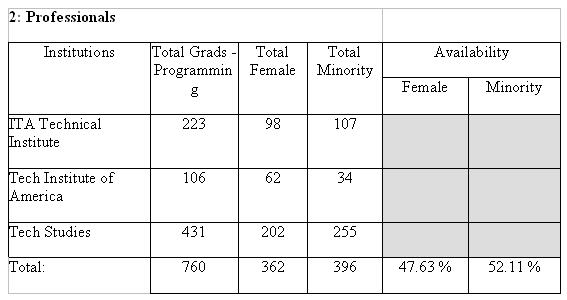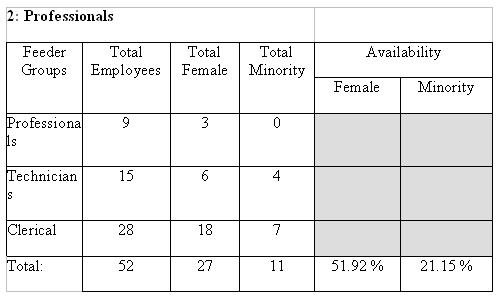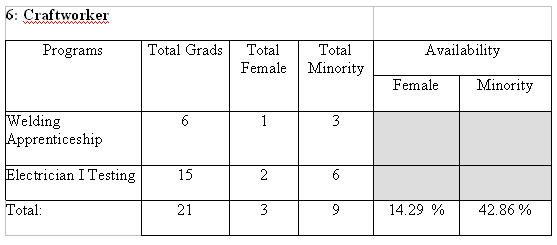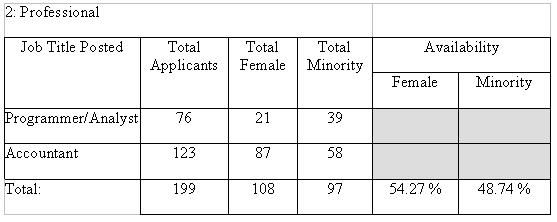Availability Calculations
The contractor may utilize the following factors within the software:
1. 41 CFR 60-2.14.c.1 The percentage of minorities or women with requisite skills in the reasonable recruitment area. The reasonable recruitment area is defined as the geographical area from which the contractor usually seeks or reasonably could seek workers to fill the positions in question.
This factor actually incorporates three items: the immediate area within the reasonable recruitment census area, the broader area within the reasonable recruitment census area, and training institutions from which the contractor recruits. The immediate and broader areas are the geographical areas from which the contractor usually seeks or reasonably could seek workers to fill positions. We separate this into factor 1a: Local Census Area and 1b: Non-Local Census Area. We also add factor 1c: Training Institutions to consider those employees who were hired as a result of recruitment efforts at local training institutions.
2. 41 CFR 60-2.14.c.2 The percentage of minorities or women among those promotable, transferable, and trainable within the contractor's organization. Trainable refers to those employees within the contractor's organization who could, with appropriate training which the contractor is reasonably able to provide, become promotable or transferable during the AAP year.
This factor is split 2a: Promotables/Transferables, and 2b: Trainable to better determine availability. Factor 2a: % Promotable refers to those employees who possess or could easily possess the skills necessary to be promoted or transferred into a higher position. Factor 2b: % Trainable refers to those employees within the contractor's organization who could, with appropriate training which the contractor is reasonably able to provide, become promotable or transferable during the AAP year.
3. User defined factor This factor was developed for those companies who use factors that are not covered by any of the others in the Job Groups screen. Some companies might use the available minorities and females in a pool of layoffs, still others might use applicant flow availability.
The basic factors are split into sub-factors to more specifically identify the rationale for weighting internal and external recruitment.
Factor 1a
Factor 1a looks specifically at the census data in the immediate labor area that is assigned to each job group. This factor takes into consideration the specific census codes assigned to each job in every job group and the number of minorities and females in the given census area who hold those jobs.
The total availability for females is calculated by adding the total number of employees in our workforce who hold a job with a specific census code. That total is then multiplied by the percent of females available for that specific census code, divided by the total number of employees in the job group. The totals are then added together. The total availability for minorities is calculated the same way using minority availability for the specific census code. This calculation is done for every census code in the job group. This method is illustrated in the table using the following formulas:
Female Availability = [(5/21 X .3127) + (3/21 X .5457) + (7/21 X .4749) + (4/21 X .6091) + (2/21 X .4076)]
Minority Availability = [(5/21 X .2928) + (3/21 X .3603) + (7/21 X .2750) + (4/21 X .3618) + (2/21 X .1852)]
Factor 1b
This factor looks specifically at the census data in the broader area within the reasonable recruitment area that is assigned to each job group. This factor takes into consideration the specific census codes assigned to each job in every job group and the number of minorities and females in the given census area who hold those jobs.
The total availability for females is calculated by adding the total number of employees in the contractor's workforce who hold a job with a specific census code. That total is then multiplied by the percent of females available for that specific census code, divided by the total number of employees in the job group. The totals are then added together. The total availability for minorities is calculated the same way using minority availability for the specific census code. This calculation is done for every census code in the job group. This method is illustrated in the table using the following formulas:
Female Availability = [(5/ 21 X .3065) + (3/ 21 X .5271) + (7/ 21 X .4514) + (4/ 21 X .5772) + (2/ 21 X .4637)]
Minority Availability = [(5/ 21 X .1567) + (3/ 21 X .1665) + (7/ 21 X .1264) + (4/ 21 X .1999) + (2/ 21 X .1380)]
Factor 1c
Factor 1c takes into consideration the use of training institutions capable of training persons in the requisite skills. The percent of female and minority graduates is the availability for factor 1c.
Factor 2a
Factor 2a calculates the availability of promotable and transferable minorities and females within the feeder groups for each job group. The number of females in each feeder group is totaled. The total females in all feeder groups are added then divided by the number of employees in all feeder groups. Minority availability is calculated the same way. The table below illustrates the method used to determine availability for factor 2a.
Factor 2b
Factor 2b calculates those employees within the contractor's organization who could, with appropriate and formal training that the contractor is reasonably able to provide, become promotable or transferable during the AAP year. The type of training can range from apprenticeships to actual training courses, as long as they are formal, established programs. The training may involve a test that an employee must pass in order to complete the program. The total number of employees eligible for the program will serve as the basis from which the availability of females and minorities is determined.
Factor 3
Factor 3 allows the contractor to utilize a customized factor. The availability for this factor is determined by the percent of females and minorities who are available using the factor chosen. An example of a custom factor that might be used is Applicant Flow. The same parameters were followed for each job group that uses Factor 3.
See Also
Job Group Edit
Glossary for definitions of census area, feeder, and promotable
© Copyright Yocom & McKee, Inc.
